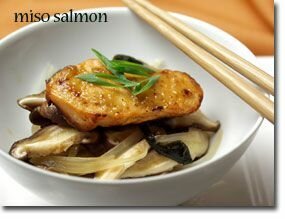If you don't know what to serve for dinner tonight ...
Try this Asian-flavored dish that is sure to become one of your favorite additions to your Healthiest Way of Eating. The salmon provides one of the best sources of those hard-to-find health-promoting omega-3 fatty acids. Enjoy!

Ingredients:
- 1 lb salmon, cut into 4 pieces, skin and bones removed
- 2 tsp light miso
- 1 TBS prepared Dijon mustard
- 2 TBS mirin (Japanese rice cooking wine found in Asian section of market)
- 4 dried medium size pieces of wakame seaweed, rinsed and soaked in 1/2 cup hot water for about 10 minutes (save water)
- 1 medium onion, cut in half and sliced
- 3 cups sliced fresh shiitake mushrooms
- 3 medium cloves garlic, chopped
- 1/2 TBS minced fresh ginger
- 2 tsp soy sauce
- salt and white pepper to taste
- garnish with minced green onion
- Preheat broiler with rack in the middle of the oven. Place a stainless steel or cast iron skillet big enough to hold salmon under heat to get very hot (about 10 minutes).
- Rinse and soak seaweed, saving the water.
- Slice onion and chop garlic and let sit for 5 minutes to enhance their health-promoting properties.
- Prepare glaze by mixing miso, Dijon mustard, and mirin along with a pinch of white pepper. Generously coat salmon with mixture and let set while preparing rest of ingredients.
- Heat 1 TBS seaweed water in a stainless steel skillet. Healthy Sauté onion, garlic, ginger, and mushrooms in broth over medium heat for about 5 minutes. Add chopped seaweed, 1/2 cup seaweed water and soy sauce and cook for another 5 minutes. Season with salt and pepper.
- Remove pan that was heating from broiler and place salmon in it. Return to broiler and cook without turning for about 3-5 minutes depending on thickness of salmon. Top with sautéed onion/mushroom mixture and minced scallion.
In-Depth Nutritional Profile for Miso Salmon
Healthy Food Tip
Can you tell me about the phenols in extra virgin olive oil?
Why is it so important to use 100% extra virgin olive oil? The reason lies in this oil's unique phenol content. Extra virgin olive oil-oil made from the first pressing of the olives-contains the phenols protocatechuic acid, oleuropein, tyrosol, hydrotyrosol, dihydroxyphenylethanol, and other unique phenyl-ethyl alcohols as well as lignans and secoiridoids. (Lignans may already be familiar to you from your reading about flaxseeds. However, it is also important to know that certain lignans-including pinoresinol and acetoxypinoresinol-are key phenol components found in extra virgin olive oil.) These phenols are most concentrated in the first pressing of olives, which make extra virgin olive oil. Subsequent pressings-even those that produce virgin olive oil-do not contain the same concentrations of these unique phenols.
The high phenol concentration in extra virgin olive oil results in three key health benefits. First is the ability of this rich phenol mixture to help protect olive oil's vitamin E. Especially during the process of heating-and even at low heating temperatures-these phenols help to stabilize the vitamin E present in extra virgin olive oil. Second is the ability of this phenol mixture to engage in free radical scavenging. Especially when it comes to the neutralization of free radicals like hydroxyl radical and superoxide anion radical, the rich phenol mixture in extra virgin olive oil is especially important. In fact, research studies have confirmed the ability of extra virgin olive oil's phenols to help protect against free radical damage to LDL cholesterol as well as cellular DNA.
Reduction of inflammatory activity is a third area of potential benefit when it comes to the rich phenol mixture in extra virgin olive oil. Studies in this area have compared extra virgin oil to olive oil from later pressings, and the results show that extra virgin olive oil is able to lower certain markers of inflammation (called TXB2 and LTB2) during a window of time 2-6 hours after consumption of the extra virgin oil where olive oil from later pressings is unable to do so.

No comments:
Post a Comment